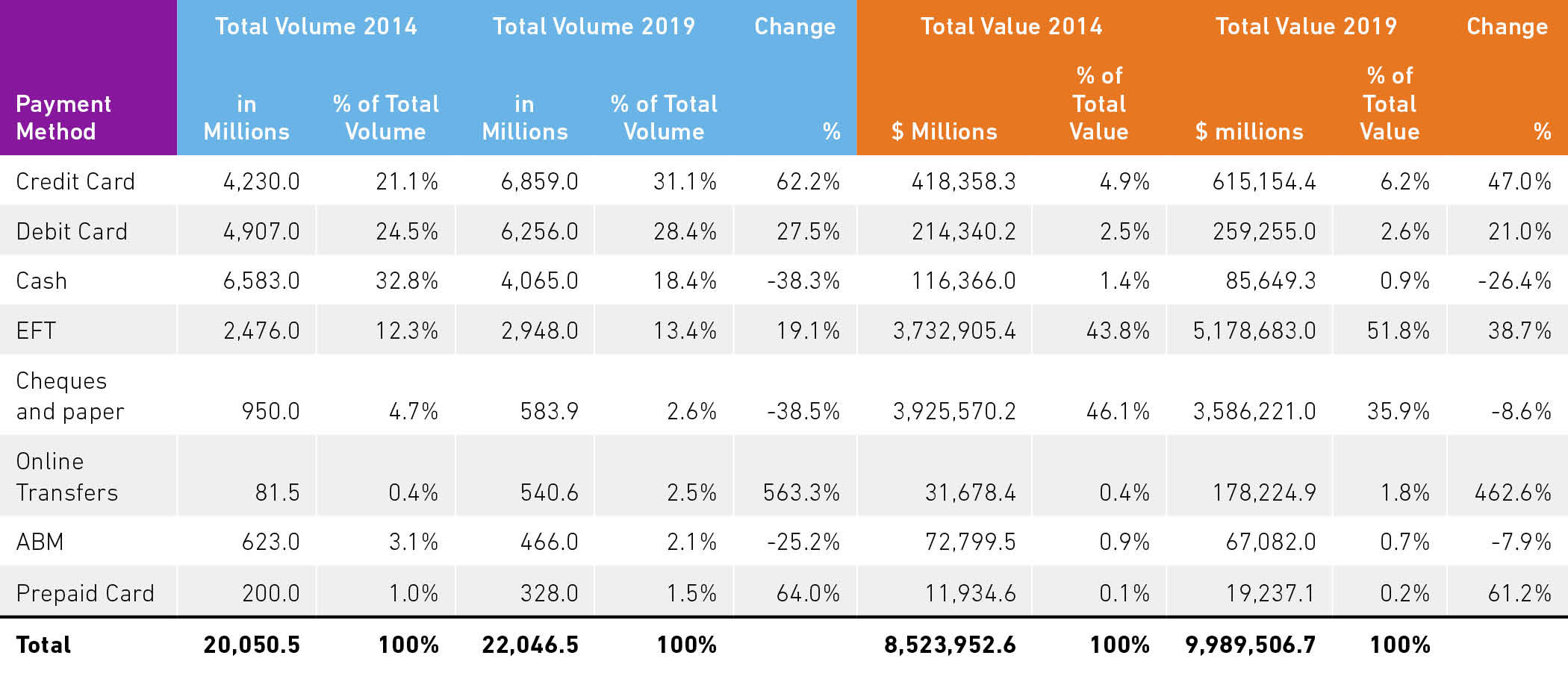Surge in electronic payments – representing around 77 per cent of all transactions, reports Payments Canada
Credit card use exceeds debit for first time with 16 per cent YOY growth; Cash use shrinks a further 9 per cent
OTTAWA, November 17, 2020 – Evolving technology and payments innovation continues to transform the way Canadian consumers and businesses make payments, according to new data from Payments Canada’s annual Canadian Payments: Methods and Trends 2020 report.
In pursuit of more convenient, faster and secure payment experiences, Canadians continue to adopt new and evolving digital payments methods and channels - including contactless (tapping card or mobile phone), wearables, in-app payments and e-commerce. The newly released 2020 report analysed the 22 billion payment transactions made in 2019, totalling CA$9.9 trillion in value. The study points to insights and trends that continue to transform the Canadian payments landscape.
“We continue to see a widespread shift away from paper-based payments, cheques and cash, as Canadians increasingly demonstrate preference for faster, easier and more secure payment experiences,” said Tracey Black, President and CEO of Payments Canada. “The migration to digital payments, a trend that we have observed for a number of years, has been accelerated by the COVID-19 pandemic. More than ever, we are seeing that Canadians’ payment preferences can be impacted by available payment options, for example, contactless payment. Innovation will continue to evolve consumer and business expectations regarding payment flexibility and efficiency.”
Key 2019 findings include:
- Electronic payments increased significantly accounting for approximately 16.9 billion transactions, representing around 77 per cent of total payments volume (number of overall payment transactions), and 62 per cent of total payments value (the combined monetary value of total transactions) in 2019.
- Debit and credit cards continued to make up the largest portion of total transaction volume representing 28 per cent and 31 per cent of total payments volumes respectively.
- The vast majority of Canadians have payment cards; about 89 per cent of Canadians reported having a credit card, and 30 per cent of Canadians reported that they carried a credit card balance at the end of each month. Around 94 per cent of Canadians reported having a debit card.
- Credit card use exceeded debit for the first time ever in 2019 growing by 16 per cent in volume and 11 per cent in value.
- Contactless payments grew dramatically increasing 15 per cent in volume and 20 per cent in value in 2019. About 34 per cent of Canadians with a credit or debit card used contactless mobile payments on a regular basis, and 39 per cent of all debit transactions were contactless.
- Online purchases were made by 86 per cent of Canadians in 2019; E-commerce payments generated over $54 billion in value, with fashion and footwear representing over half of online purchases.
- Canadians continue to adopt new payment options; about 18 per cent of Canadians made in-app purchases, and about 15 per cent of Canadians made purchases using gaming consoles or Internet of Things (IoT) devices. Wearables (for example, smart watches) are increasing in popularity, and 34 per cent of Canadians who own a wearable reported using the wearable to make a purchase.
- Online transfers continued to grow in 2019, but growth is slowing; online transfer volumes increased by 36 per cent in volume and 32 per cent in volume in 2019. Online transfers accounted for over 540 million transactions representing 178 billion in value. The average value of an online transfer declined by about $10.00 to $330.00.
- Electronic funds transfers (EFTs) represented the largest portion of total transaction value accounting for 52 per cent of total payments value in 2019. Growth in EFT value continues to be driven by business usage to support payroll, government payments and bill payments, and other use cases.
- Debit and credit cards continued to make up the largest portion of total transaction volume representing 28 per cent and 31 per cent of total payments volumes respectively.
- Paper-based payments continued to decline in 2019 accounting for approximately 3.7 billion transactions representing 23 per cent of total payments volume. Cheques and paper-based payments continued to play a significant role, accounting for 35.9 per cent of total payments value. Other paper-based payment methods, cash and ABM withdrawals, accounted for only 1.5 percent of total value.
- Cash payments declined by nine per cent in 2019 with cash usage accounting for just less than 19 per cent of total payments volume and is expected to continue to decline steadily. Interestingly, 61 per cent of Canadians reported making a cash purchase in the last seven days.
- Cheque volumes and values continued to decline, while average value of cheques increased; consumer cheques declined by about 12 per cent in volume and seven per cent in value in 2019. Corporate cheque volumes declined by 15 per cent but the average value of a corporate cheque increased by about five per cent. Cheques remain an important payment option for large value corporate payments.
- Cash payments declined by nine per cent in 2019 with cash usage accounting for just less than 19 per cent of total payments volume and is expected to continue to decline steadily. Interestingly, 61 per cent of Canadians reported making a cash purchase in the last seven days.
Summary of all payment totals by volume and value of transactions over last five years (2014 vs 2019)
Looking at 2020 and the impact of COVID-19 on Canadian payments trends:
The COVID-19 pandemic deeply impacted the global payments industry in early 2020, as millions of businesses and consumers shifted their payment behaviour. In particular, Payments Canada’s payment trends during COVID-19 study in 2020 indicated that the pandemic further accelerated digital and contactless payments. Additional 2020 expected payments shifts include:
- Canadians spending less: In the first few weeks of the pandemic, 75 per cent of Canadians indicated they were spending less as they stayed home, overall incomes decreased and people became more wary of their personal finances.
- Contactless payments continue to grow: Canadian consumers and businesses are expected to continue to favour contactless payment methods due to concern around transmitting the virus through surface contact. In the early months of the pandemic, 40 per cent of Canadians avoided retailers that did not accept contactless payments.
- Accelerated decline in cash use: Concerns of excessive surface contact through cash and coins has both merchants and consumers shifting away from regular cash usage and acceptance.
- E-commerce growth: There is an expected rise in the volume and value of e-commerce transactions as more Canadians ‘shop from home’ with less brick and mortar shopping. Physical locations of businesses will likely pivot to e-commerce in order to meet consumer demand and reduce overall costs.
“Looking to the future, the payments landscape will continue to evolve dramatically, fuelled by new technologies, consumer demands and shifting competitive dynamics,” said Cyrielle Chiron, Payments Canada’s Head of Research and Strategic Foresight. “Beyond the continued shift toward digital and contactless payments, Payments Canada is building the foundation for the next generation of payments to ensure Canadian consumer and business needs for more control, speed, convenience and affordable payments methods are met. This includes future opportunities for innovation with the launch of Canada’s real-time rail in 2022.”
The Canadian Payments: Methods and Trends 2020 report was compiled by Payments Canada with the help of payment service providers, payments consultants and researchers to help build a comprehensive understanding of the Canadian payments landscape in 2019.
About Payments Canada
Payments Canada ensures that financial transactions in Canada are carried out safely and securely each day. The organization underpins the Canadian financial system and economy by owning and operating Canada’s payment clearing and settlement infrastructure, including associated systems, bylaws, rules and standards. The value of payments cleared and settled by Payments Canada in 2019 was over $55 trillion or $218 billion each business day. These encompass a wide range of payments made by Canadians and businesses involving inter-bank transactions, including those made with debit cards, pre-authorized debits, direct deposits, bill payments, wire payments and cheques. Payments Canada is a proud supporter of the Catalyst Accord and the 30% Club.
For media inquiries, please visit the Media Centre.




